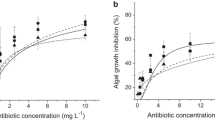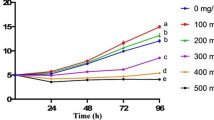Abstract
Algal species Raphidocelis subcapitata and Chlorella vulgaris are commonly used to test the chemicals with an antibacterial mode of action during marketing authorization process. However, significant differences in the sensitivity toward antibiotic exposure have been reported. The selection of an inappropriate test species would thus underestimate the environmental hazard of target chemicals and pose a potential threat to the ecosystem. Since oxidative stress is a crucial factor determining the inhibition of algal growth, an investigation on oxidative stress and antioxidant defense mechanisms in these two species was performed to explore its roles in species sensitivity. Here, roxithromycin (ROX), a macrolide antibiotic extensively used to treat respiratory, urinary and soft tissue infections, was used for testing. After 7 days exposure to ROX at the low (0.01 mg L−1) and high (0.09 mg L−1) concentrations, R. subcapitata was inhibited while the growth of C. vulgaris was stimulated. We investigated the roles of oxidative stress in algae by measuring the oxidative stress biomarkers (MDA), non-enzymatic antioxidants (GSH), and antioxidant enzymes (SOD, CAT, GP, GST). The results suggested that when the growth of algae is inhibited, MDA content as well as activities of oxidative stress enzymes would increase, and thus, activating the antioxidant system. On the contrary, it was inferred that when the growth is stimulated, MDA content and oxidative stress enzymes activities would decrease.





Similar content being viewed by others
Data availability
The data that support the findings of this study are available on request from the corresponding author.
References
Adachi F, Yamamoto A, Takakura K, Kawahara R (2013) Occurrence of fluoroquinolones and fluoroquinolone-resistance genes in the aquatic environment. Sci Total Environ 444:508–514
Bialk-Bielinska A, Caban M, Pieczynska A, Stepnowski P, Stoltz S (2017) Mixture toxicity of six sulfonamides and their two transformation products to green algae Scenedesmus vacuolatus and duckweed Lemna minor. Chemosphere 173:542–550
Chen Z, Wang J, Chen H, Wen Y, Liu W (2017) Enantioselective phytotoxicity of dichlorprop to arabidopsis thaliana: the effect of cytochrome P450 enzymes and the role of Fe. Environ Sci Technol 51:12007–12015
Choi K, Kim Y, Jung J, Kim MH, Kim CS, Kim NH, Park J (2008) Occurrences and ecological risks of roxithromycin, trimethoprim, and chloramphenicol in the Han River, Korea. Environ Toxicol Chem 27:711–719
Distefano S, Palma J, McCarthy I, Rio L (1999) Proteolytic cleavage of plant proteins by peroxisomal endoproteases from senescent pea leaves. Planta 209:308–313
EC (2019) European union strategic approach to pharmaceuticals in the environment. https://ec.europa.eu/commission/news/pharmaceuticals-environment-2019-mar-11_en
Elbaz A, Wei Y, Meng Q, Zheng Q, Yang Z (2010) Mercury-induced oxidative stress and impact on antioxidant enzymes in Chlamydomonas reinhardtii. Ecotoxicology 19:1285–1293
European Medicines Agency (2018). Guideline on the environmental risk assessment of medicinal products for human use. https://www.ema.europa.eu/en/environmental-risk-assessment-medicinal-products-human-use
Gao L, Shi Y, Li W, Niu H, Liu J, Cai Y (2012) Occurrence of antibiotics in eight sewage treatment plants in Beijing, China. Chemosphere 86:665–671
Gill S, Tuteja N (2010) Reactive oxygen species and antioxidant machinery in abiotic stress tolerance in crop plants. Plant Physiol Biochem 48:909–930
Gorokhova E, Rivetti C, Furuhagen S, Edlund A, Ek K, Breitholtz M (2015) Bacteria-mediated effects of antibiotics on daphnia nutrition. Environ Sci Technol 49:5779–5787
Guo J, Boxall A, Selby K (2015) Do pharmaceuticals pose a threat to primary producers? Environ Sci Technol 45:2565–2610
Guo J, Selby K, Boxall A (2016a) Effects of antibiotics on the growth and physiology of chlorophytes, cyanobacteria, and a diatom. Arch Environ Contam Toxicol 71:589–602
Guo J, Selby K, Boxall AB (2016b) Comparing the sensitivity of chlorophytes, cyanobacteria, and diatoms to major‐use antibiotics. Environ Toxicol Chem 35:2587–2596
Guo J, Selby K, Boxall A (2016c) Assessment of the risks of mixtures of major use veterinary antibiotics in European surface waters. Environ Sci Technol 50:8282–8289
Guo J, Sinclair CJ, Selby K, Boxall A (2016d) Toxicological and ecotoxicological risk-based prioritization of pharmaceuticals in the natural environment. Environ Toxicol Chem 35:1550–1559
Guo J, Peng j, Lei Y, Kanerva M, Li Q, Song J, Guo J, Sun H (2019) Comparison of oxidative stress induced by clarithromycin in two freshwater microalgae Raphidocelis subcapitata and Chlorella vulgaris. Aquat Toxicol 105376:1–9
He L, Ying G, Liu Y, Su H, Chen J, Liu S, Zhao J (2016) Discharge of swine wastes risks water quality and food safety: antibiotics and antibiotic resistance genes from swine sources to the receiving environments. Environ Int 92-93:210–219
Jahns P, Holzwarth A (2012) The role of the xanthophyll cycle and of lutein in photoprotection of photosystem II. Biochim Biophys Acta 1817:182–193
Jiang Y, Li M, Guo C, An D, Xu J, Zhang Y, Xi B (2014) Distribution and ecological risk of antibiotics in a typical effluent-receiving river (Wangyang River) in north China. Chemosphere 112:267–274
Kabra A, Ji M, Choi J, Kim J, Govindwar S, Jeon B (2014) Toxicity of atrazine and its bioaccumulation and biodegradation in a green microalga, Chlamydomonas mexicana. Environ Sci Pollut Res 21:12270–12278
Kanerva M, Vehmas A, Nikinmaa M, Vuori KA (2014) Spatial variation in transcript and protein abundance of Atlantic salmon during feeding migration in the Baltic Sea. Environ Sci Technol 48:13969–13977
Kasahara KM, Oikawa T, Suetsugu K, Miyao N, Wada M (2002) Chloroplast avoidance movement reduces photodamage in plants. Nature 420:829–832
Kummerer K (2009) Antibiotics in the aquatic environment–a review–part I. Chemosphere 75:417–434
Kurade M, Kim J, Govindwar PS, Jeon B (2016) Insights into microalgae mediated biodegradation of diazinon by Chlorella vulgaris: microalgal tolerance to xenobiotic pollutants and metabolism. Algal Res 20:126–134
Li Q, Cheng B, Liu S, Zhang Y, Zhou Li, Guo J (2019) Assessment of the risks of the major use antibiotics in China’s surface waters using a probabilistic approach. Integr Environ Assess Manag. https://doi.org/10.1002/ieam.4204
Lichtenthaler HK, Wellburn AR (1983) Determination of total carotenoids and chlorophylls a and b of leaf extracts in different solvents. Biochem Soc Trans 11:591–603
Lin K, Luo L, Wang P, Luan T, Tam N (2010) Effects of metals on biosorption and biodegradation of mixed polycyclic aromatic hydrocarbons by a freshwater green alga Selenastrum capricornutum. Bioresour Technol 101:6950–6961
Liu F, Ying G, Tao R, Zhao J, Yang J, Zhao L (2009) Effects of six selected antibiotics on plant growth and soil microbial and enzymatic activities. Environ Pollut 157:1636–1642
Liu J, Lu G, Wang Y, Yan Z, Yang X, Ding J, Jiang Z (2014) Bioconcentration, metabolism, and biomarker responses in freshwater fish carassius auratus exposed to roxithromycin. Chemosphere 99:102–108
Moran J, James E, Rubio M, Sarath G, Klucas R, Becana M (2003) Functional characterization and expression of a cytosolic iron-superoxide dismutase from Cowpea root nodules. Plant Physiol 133:773–782
Nemat A, Hassan N (2006) Changes of antioxidants levels in two maize lines following atrazine treatments. Plant Physiol Biochem 44:202–210
Nie X, Liu B, Yu H, Liu W, Yang Y (2013) Toxic effects of erythromycin, ciprofloxacin and sulfamethoxazole exposure to the antioxidant system in Pseudokirchneriella subcapitata. Environ Pollut 172:23–32
Noctor G, Foyer C (1998) Ascorbate and glutathione: keeping active oxygen under control. Annu Rev Plant Physiol Plant Mol Biol 49:249–279
OECD (1984) Guideline for testing of chemicals: alga, growth inhibition test. https://www.oecd-ilibrary.org/environment/test-no-201-alga-growth-inhibition-test_9789264069923-en. Accessed 15 May 2019
OECD (2011) OECD guidelines for the testing of chemicals, freshwater alga and cyanobacteria, growth inhibition test. http://www.oecd-ilibrary.org/environment/test-no-201-algagrowth-inhibition-test_9789264069923-en. Accessed 10 June 2019
Pan C, Peng F, Shi W, Hu L, Wei X, Ying G (2018) Triclosan-induced transcriptional and biochemical alterations in the freshwater green algae Chlamydomonas reinhardtii. Ecotoxicol Environ Safe 148:393–401
Pryor W, Stanley J (1975) Letter: a suggested mechanism for the production of malonaldehyde during the autoxidation of polyunsaturated fatty acids. Nonenzymatic production of prostaglandin endoperoxides during autoxidation. J Org Chem 40:3615–3617
Sanchez D, Houde M, Douville M, Silva A, Spencer C, Verreault J (2015) Transcriptional and cellular responses of the green alga Chlamydomonas reinhardtii to perfluoroalkyl phosphonic acids. Aquat Toxicol 160:31–38
Schafer F, Buettner G (2001) Redox environment of the cell as viewed through the redox state of the glutathione disulfide/glutathione couple. Free Radic Bio Med 30:1191–1212
Torres MA, Barros MP, Campos S, Pinto E, Rajamani S, Sayre RT, Colepicolo P (2008) Biochemical biomarkers in algae and marine pollution: a review. Ecotoxicol Environ Saf 71:1–15
Tsiaka P, Tsarpali V, Ntaikou I, Kostopoulou M, Lyberatos G, Dailianis S (2013) Carbamazepine-mediated pro-oxidant effects on the unicellular marine algal species Dunaliella tertiolecta and the hemocytes of mussel Mytilus galloprovincialis. Ecotoxicology 22:1208–1220
Weckx JEJ, Clijsters HMM (1996) Oxidative damage and defense mechanisms in primary leaves of Phaseolus vulgaris as a result of root assimilation of toxic amounts of copper. Physiol Plant 96:506–512
Wellburn AR (1994) The spectral determination of chlorophyll-a and chlorophyll-b, as well as total carotenoids, using various solvents with spectrophotometers of different resolution. J Plant Physiol 144:307–313
Xiong J, Kurade M, Abou-Shanab R, Ji M, Choi J, Kim J, Jeon B (2016) Biodegradation of carbamazepine using freshwater microalgae Chlamydomonas mexicana and Scenedesmus obliquus and the determination of its metabolic fate. Bioresour Technol 205:183–190
Xiong J, Kurade M, Jeon B (2017b) Ecotoxicological effects of enrofloxacin and its removal by monoculture of microalgal species and their consortium. Environ Pollut 226:486–493
Xu D, Xiao Y, Pan H, Mei Yu (2019) Toxic effects of tetracycline and its degradation products on freshwater green algae. Ecotoxicol Environ Safe 174:43–47
Yang L, Ying G, Su H, Stauber J, Adams M, Binet M (2008) Growth-inhibiting effects of 12 antibacterial agents and their mixtures on the freshwater microalga Pseudokirchneriella subcapitata. Environ Toxicol Chem 27:1201–1208
Ying G, He L, Ying A, Zhang Q, Liu Y, Zhao J (2017) China must reduce its antibiotic use. Environ Sci Technol 51:1072–1073
Zhang S, Ding J, Razanajatovo R, Jiang H, Zou H, Zhu W (2018) Interactive effects of polystyrene microplastics and roxithromycin on bioaccumulation and biochemical status in the freshwater fish red tilapia (oreochromis niloticus). Sci Total Environ 648:1431–1439
Zhang W, Zhang M, Lin K, Sun W, Xiong B, Guo M, Cui X, Fu R (2012) Eco-toxicological effect of carbamazepine on Scenedesmus obliquus and Chlorella pyrenoidosa. Environ Toxicol Pharmacol 33:344–352
Zhu X, Long S, Donald R (2008) What is the maximum efficiency with which photosynthesis can convert solar energy into biomass? Curr Opin Biotechnol 19:153–159
Funding
This work was funded by ShaanXi Thousand Talent Program for Young Outstanding Scientists given to Dr Jiahua Guo (No. 334041900007). This work was also supported by the Starting Research Fund from the Northwest University (No. 338050064) and the National Key Research and Development Program of China (No. 2017YFC1502506).
Author information
Authors and Affiliations
Corresponding author
Ethics declarations
Conflict of interest
The authors declare that they have no conflict of interest.
Ethical approval
This article does not contain any studies with human participants or animals performed by any of the authors.
Additional information
Publisher’s note Springer Nature remains neutral with regard to jurisdictional claims in published maps and institutional affiliations.
Supplementary information
Rights and permissions
About this article
Cite this article
Han, Q., Zheng, Y., Qi, Q. et al. Involvement of oxidative stress in the sensitivity of two algal species exposed to roxithromycin. Ecotoxicology 29, 625–633 (2020). https://doi.org/10.1007/s10646-020-02192-6
Accepted:
Published:
Issue Date:
DOI: https://doi.org/10.1007/s10646-020-02192-6




